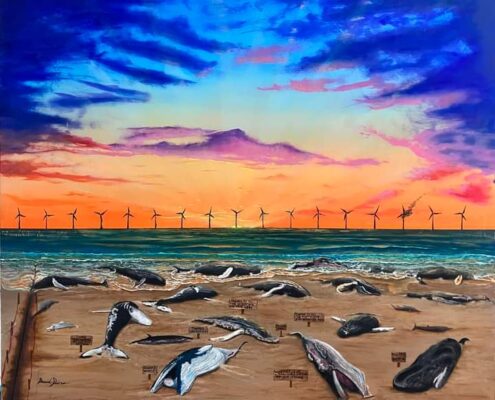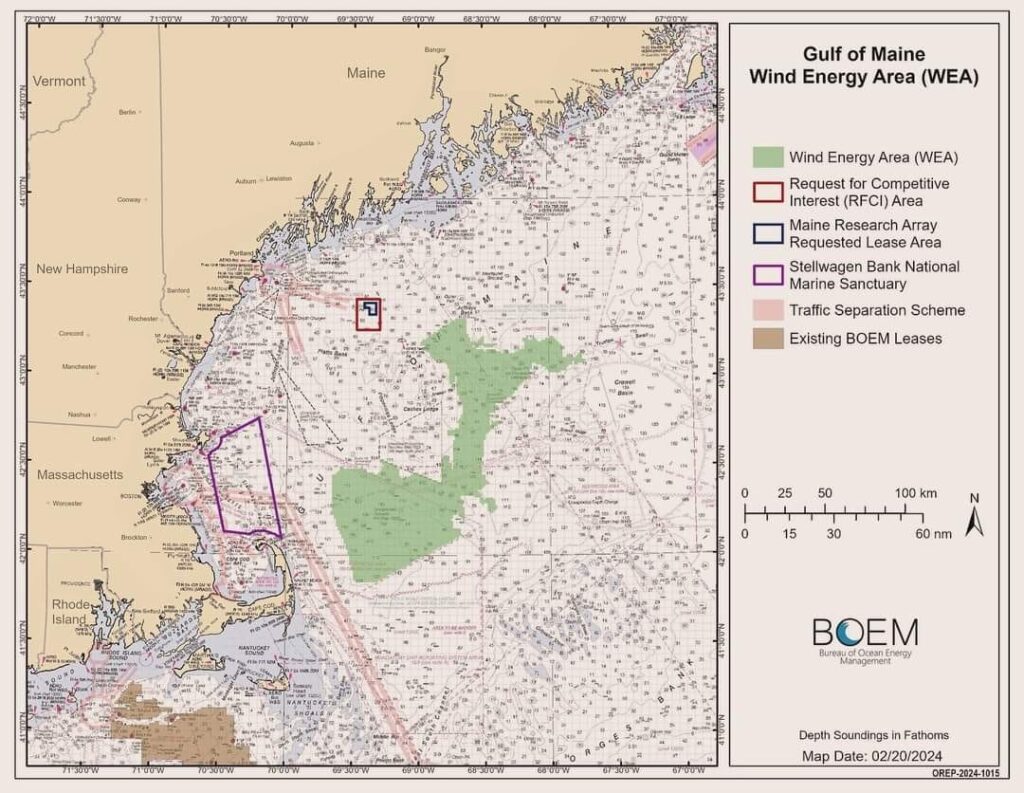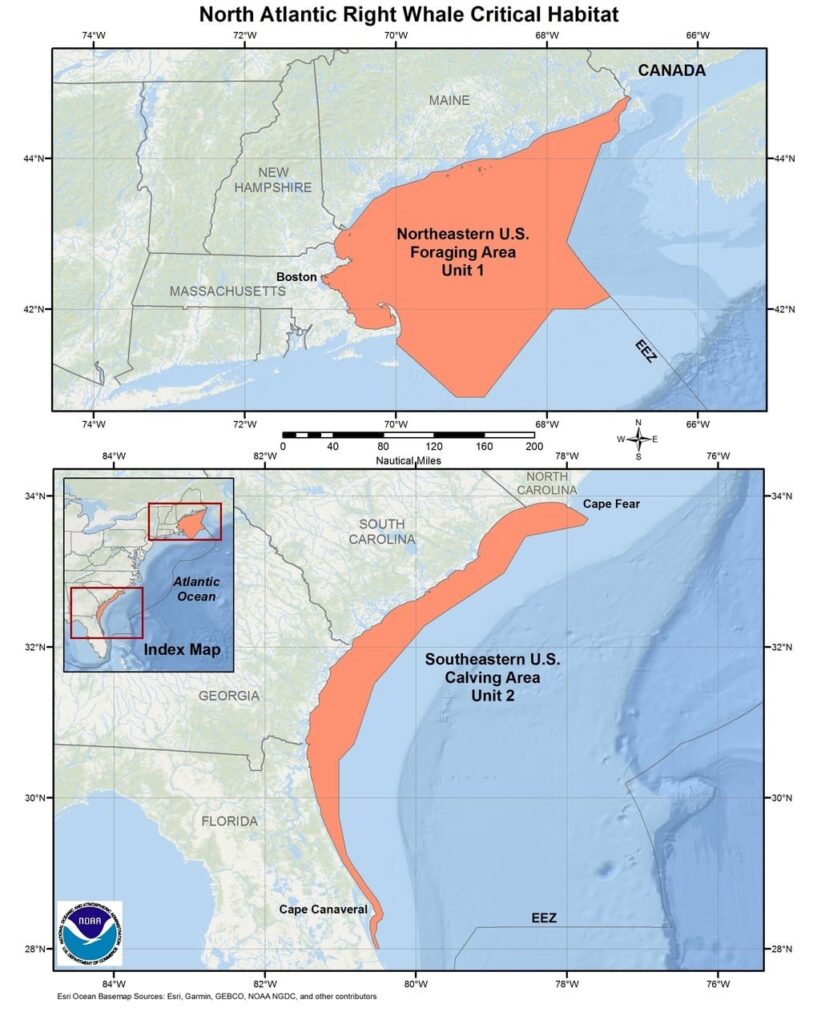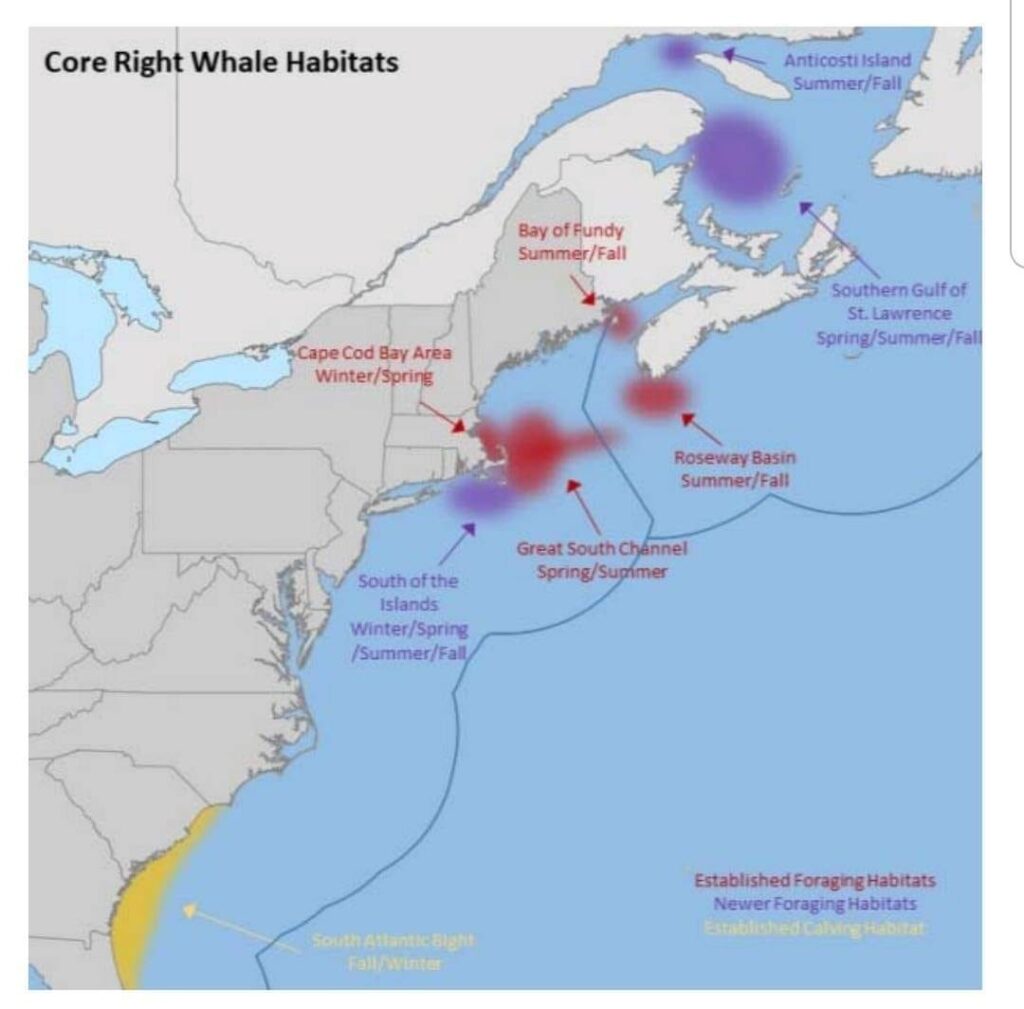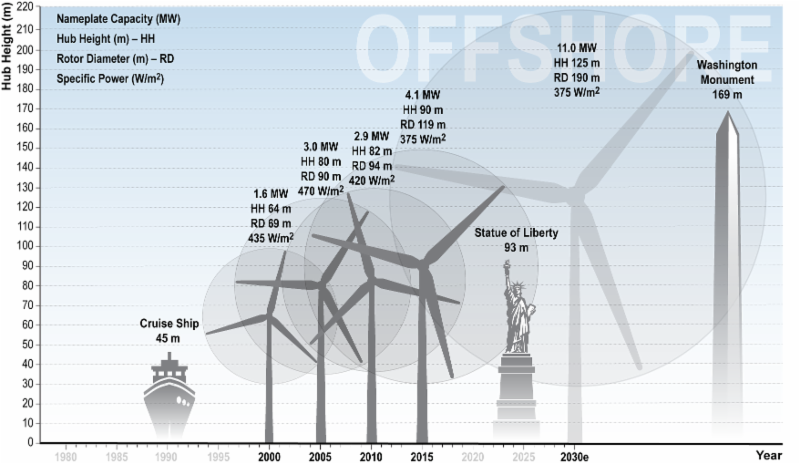New Hampshire has about 18 miles of coast along the Atlantic Ocean. The port of Portsmouth, still a working port, much to the chagrin of the new residents there, leads into the Great Bay and Little Bay watershed. Over the years, it has seen its share of controversy.
The featured Image is an original artwork used with permission from a local artist: David Riina.com
I remember in the early 1970s, Aristotle Onassis was going to put the largest oil refinery in the world in Great Bay. Piping oil from the Isle of Shoals to a refinery in Great Bay in Durham. The environmentalists opposed it, politicians ran on it, and it died. Then, the Seabrook Nuclear Station brought the legendary Clamshell Alliance into being. A 20,000-person occupation took place. Musicians held vigil (I still hear “NO NUKES” in my head”), songs were written, and people were arrested. The nuke plant prevailed but with many prohibiting factors, some of them good. A tragic oil spill in the Bay during the mid-70s traveled to all the towns along every connecting river, which brought bleeding hearts from all over the country to save the wildlife, among other events.
New Hampshire has always been protective of their small but great connection to the Atlantic. The latest barrage of saviors is bringing new restrictions on people with roofs and farms for nitrogen, phosphates, and other human interactions that they say are killing all grass in the Bay and poisoning the Atlantic with absolutely no detailed, long-term studies or proof.
We want to thank Julie P. for this Contribution – Please direct yours to Steve@GraniteGrok.com.
You can review our ‘Op-Ed Guidelines‘ on the FAQ Page.
Yet, with all the issues we have to deal with environmentalists today, I am absolutely astonished by the Off Shore Wind Farms (OSW) and the dead ocean mammals (4 dolphins in 2 days this past weekend) floating in the ocean and washing up on the beaches where OSW is built and under construction, receives “crickets”… No bull horns, no boats circling the windmills, no spray paint, no protests at the companies (and government) responsible, no songs, nothing. It is the opposite! Local Portsmouth non-profits such as this group, Seacoast Anti-pollution League, promote OSW and say, “Sea creatures have much worse things to worry about like pollution, overfishing/fishing gear, and climate disruption.”
The federal Bureau of Ocean Energy Management (BOEM), on March 18, 2024, opened two new environmental assessments of offshore wind power: one for the agency’s proposed Gulf of Maine wind energy areas, the other for the Atlantic Shores project off New Jersey. They are proud of reducing the Gulf area by 85%, but it still encompasses 2 million acres of prime fishing and marine wildlife feeding and migrating areas. The maps below show impact on several whale habitats.
What they don’t mention is the construction phase of this will annihilate all living creatures for miles, and the cables carrying 600,000gw of power have to get to shore through beaches and roads to a transfer switch station. The cabling construction will have a direct impact on shellfish and other creatures that live close to the shore for miles as well. After installation, dangerous Electromagnetic Pulses (EMPs) and other impacts have not been addressed. All one has to do is look at the shores of NJ, Virginia, and NY to see the devastation and frequent dead mammals washed up onto the beaches. Our money is donated to such non-profits and aquariums to toe the line on OSW as the second coming.
OSW has been in the pipeline for many years, and until the Green New Deal and all its money put into these projects, it has fast-tracked the industry without any studies or data on the impact on the ocean or marine life. We have Governor Chris Sununu to thank for the Tri-State “Task Force.” A large group of government officials and their friends, along with a few fishermen in Maine, Massachusetts, and New Hampshire. Here are the stakeholders:
Recent Timeline:
2019: Sununu requested the BOEM to establish the Gulf of Maine Intergovernmental Renewable Energy Task Force with membership from New Hampshire, Massachusetts, Maine, and all federally recognized Tribes in the Gulf of Maine Region.; Governor Sununu signs Executive Order 2019-06 supporting the efforts of the Task Force and directing the NH Office of Strategic Initiatives, the NH Department of Environmental Services, and the NH Department of Business and Economic Affairs to produce a report on greenhouse gas emissions and port & transmission infrastructure in New Hampshire as it relates to the potential for the deployment of offshore wind in the Gulf of Maine. BOEM holds the first meeting of the Tri-State Task Force with presentations from BOEM, other federal agencies, all three states, and other stakeholders.
2020: Governor Sununu signs HB 1245, which includes the creation of the NH Commission to Study Offshore Wind and Port Development; the Commission, chaired by NH State Senator David Watters, meets monthly and includes representatives from state government, the business community (including NH’s commercial fishing industry), and labor unions. – Governor Sununu signs Executive Order 2021-03 reiterating his support for the exploration of offshore wind in the Gulf of Maine and updating his previous Executive Order to extend the deadline for the study on greenhouse gas emissions and port & transmission infrastructure. BOEM, New Hampshire, Maine, and Massachusetts resume the activities of the Task Force, specifically developing a plan and timeline for the next phase of BOEM’s process, which is the siting and leasing process; this includes creating a regional stakeholder engagement plan, which will support each of the states’ individual stakeholder engagement plans
2022: the BOEM first steps in the commercial leasing process for the Gulf of Maine. Biden-Harris Administration Continues Offshore Wind Momentum, Announces Next Steps for Gulf of Maine. New steps to spur offshore wind development and investments from the Inflation Reduction Act will lower energy costs and create good-paying jobs (for other countries).
Current: NH is actively interviewing for an “Offshore Wind Director Summary: To administer agency objectives by assessing and coordinating the needs of the State’s activities regarding offshore wind, particularly as it relates to offshore wind deployment in the Gulf of Maine; makes recommendations for short-term policies or procedures.” Interestingly, the job description does not mention the safety and study of marine life or the ocean.
OSW in the Gulf of Maine is off and running, full steam ahead and NH has rolled out the red tide of death allowing this without any regard to the ocean or marine life!
State of New Hampshire study: https://www.energy.nh.gov/renewable-energy/office-offshore-wind-industry-development
Below are the contractors listed in the contract and what they are tasked to do. The contract ended, and there is no indication it will continue as the NHDOE says it was to write a study, nothing about further testing or studies or gathering data on Offshore wind and the impact on marine life or the ocean. When asked, the NHDOE said no additional studies! One other red flag is all this is just desktop data mining, with no boots on the ground or ocean! There is a plethora of data in this report. None of which answer some of the tasks in the original contract.
The NHDOE claims we have no say regarding OSW in the area outlined by BOEM is in federal waters, (3 miles out is NH and 200 miles USA federal waters then international)! Somehow, this does not make sense because, as a state, we are supposed to tell the federal government what we want. If Maine controls the wind electricity, will NH benefit? NHDOE states, “Indirectly. If additional electricity is being generated, and demand stays constant, prices will decrease for the entire region.” There are no agreements made for the purchase of off shore wind by the state of NH. When asked about protecting our shores? I was referred to another government agency where no additional data was available. “The New Hampshire Coastal Program is responsible for issuing all federal consistency decisions in New Hampshire.”
Highlights from the original request and the final study:
The report is listed on the state web page: (typos are in the original docs)
“The Contractor shall be engaged by, and report to, the New Hampshire Department of Energy (DOE), to assess and report on the potential environmental, economic, and energy impacts in New Hampshire of development of offshore wind projects in the Gulf of Maine.”…“Normandeau Associates, Inc., Veritas Economics Consulting, and Tetra Tech, Inc. 2023. Potential Environmental, Economic, and Energy Impacts in New Hampshire from Development of Offshore Wind in the Gulf of Maine. Prepared for New Hampshire Department of Energy. 439 p plus Appendices.”
Normandeau Associates, Bedford NH:
“Wind Power Industry, Ecological and Regulatory Permitting Services” among other energy markets
Normandeau will conduct a desktop assessment of the potential environmental impacts of offshore wind development in the Gulf of Maine. The assessment will be geographically focused on potential impacts that are most relevant to New Hampshire. We will review existing publicly available information for important biological resources including birds, bats, fish, benthos and fish habitats, marine mammals, and sea turtles. Specific attention will be provided to the most sensitive species and habitats, Includihg the critically endangered North Atlantic right whale and commercially Important American lobster… Norrhandeau will gather and summarize information on existing databases and literature for each of the resources: birds and bats, fish and fisheries study, manne mammals and sea turtles, and sand and gravel.”
Veritas is listed for the following task. “Veritas Econimics uses modern microenconomic methods to address important environmental, resource and health problems.”
The contract states:
“Economic Impacts to Maritime Industries and Activities Veritas will evaluate the economic impacts to maritime industries and activities from offshore wind development… Veritas will use this model to assess the effects of offshore wind develophient on commercial fisheries and to characterize the effect that offshore wind development can have on commercial fishing.
Tetra Tech https://www.tetratech.com/solutions/energy/offshore-wind/ is listed for the following “desktop” tasks abridged…
“Tetra Tech will prepare an assessment of potential air emissions created by offshore wind operations for a hypothetical facility in the Gulf of Maine, which will specifically address potential emissions of sulfur hexafluoride (SFg), which is a potent greenhouse gas (GHG) commonly used… Tetra Tech will prepare an assessment to discuss and identify potential risks and constraints’ associated with the use of rare earth minerals in offshore wind turbines…. Tetra Tech will prepare an acoustic assessment describing potential sound impacts associated with offshore wind turbine operations. Applicable noise regulations will be discussed and a range of wind turbine sound power levels for larger offshore wind installations. A discussion of construction activities will also be included in the assessment, and the implications of both underwater and in-air noise impacts, focusing on pile driving activities. Screening-level sound propagation calculation will also be conducted to predict received sound levels onshore related to offshore pile driving.
While assessment of underwater noise impacts on marine species is a critical component to offshore wind facility permitting, for the purpose of this study, underwater noise impacts will be addressed in a qualitative manner. … Noise prediction results will be used for the purposes of providing an estimate of noise impacts.” Tetra Tech will prepare an acoustic assessment describing potential sound impacts associated with offshore wind turbine operations. Applicable noise regulations will be discussed and a range of wind turbine sound power levels for larger offshore wind installations.
A discussion of construction activities will also be included in the assessment and the implications of both, underwater and in-.air noise impacts; focusing on pile driving activities. Screening-level sound propagation calculation will also be conducted to predict received sound levels onshore related to offshore pile driving. While assessment of underwater noise impacts on marine species is a critical component to offshore wind facility permitting, for the purpose of this study, underwater noise impacts will be addressed in a qualitative manner.
Tetra Tech will base this assessment on a hypothetical project, similar in scale to those currently in development in southern New England, based on publicly-available information sources. No comprehensive acoustic modeling will be completed for this task. Calculations will correspond to more simplistic sound propagation calculations. Noise prediction results will be used for the purposes of providing an estimate of noise impacts.”
Summary:
Each subcontractor is in the ‘wind” business in some way. Can we trust them to be impartial or even objective, as it is likely they receive federal grants for offshore wind study and development? I could not find financials on them worth sharing, but they seem to be doing very well. In the summary of pros and cons, they only mention birds and bats needed more study. When they refer to Right Whales, the concern is tourism! The original request was not fulfilled as many of the items still remain unanswered, and there is no plan to answer them…
Page 284 does confirm the threat to Right Whale habitat. There is much discussion about the depth of the cables and how deep whales go to forage, but no data on the harm from the electricity or the whales in general. They also spend and refer to whale deaths and entanglements caused by fishermen. Details on food or grazing patterns, mating, and whale noise (not in conjunction with wind farms), and migration patterns. According to this study, there are 336 right whales as of 2021! That’s not a lot. These numbers are provided by Passive acoustic monitoring, page 243, patterns. Page 245: “There are 21 species of cetaceans (whales, dolphins, and porpoises), four species of seals, and four species of sea turtles that inhabit the GOM and RFI Area. Among the 21 species of cetaceans, 5 whales (blue, fin, North Atlantic right (NARW), sei, and sperm) are designated as endangered under the ESA.” species of marine animals in the target area, gulf of Maine to Massachusetts. On page 247, they list the Biologically Important Areas for many species. I did not find any details on dead marine mammals, cause and location. This study did confirm that offshore wind farms create noise, have toxic elements, have vibration and visual impacts, use rare earth minerals, and more, not including a vast list of construction issues. What the study did not do was state how all this will affect marine life or where we go from here.
If Offshore Wind Farms’ “sound,” “pollution,” or “noise” is not an issue, why are we paying for studies that don’t say anything? Why and what are “sulfur hexafluoride a potent green house gas” doing in wind turbines and what does it do? What and why is the use of “rare earth minerals in offshore wind turbines”, disposal, and maintenance? Where is a plan that if an OSW generator blows up or leaks oil, what will they do, and who will be responsible? What if a hurricane destroys them and the cabling? Where is the ocean’s plant life mentioned and considered? What about the gallons of hot chlorinated water used to cool the High Voltage Direct Current Cooling (HVDC) being dumped into the ocean?? These are just highlights! There are too many questions and not enough answers.
The Gulf of Maine has been identified as a strategic area for Biden’s offshore wind plan. So buckle up, Maine, New Hampshire, and Massachusetts. The Green New Deal is coming for your lobster, boating, fishing, and tourism industry. I’m not entirely sure what to make of the NH state study, but it does supply us with some baseline data. The closest active offshore wind farm is off Marthas Vineyard, the “Vineyard Wind Project1” and south. Construction of OSW has begun in Searsport, Maine, a pristine natural habitat for a plethora of species on and off shore. Millions of our dollars and jobs will go toward foreign companies for the manufacture and installment of these monsters. See this diagram of the sheer size of them, courtesy of Ocean City, MD. The BOEM just approved an additional 84 new OSW turbines that will be nearly 800’ tall (243.84m).. The Sunrise Wind project will provide 800mw to New York, not Massachusetts. Visible from Cape Cod and the Islands, the Vinyard Wind project will be the largest in the country. There is no mention of the impact on the ocean and marine life.
The landmark court decisions to stop construction due to lack of study and data on the marine ecosystem are coming in fast and furious. France’s Council of State has halted all Wind projects, calling them illegal and requiring full environmental assessments. https://www.na-paw.org/pr-240317-France.php?fbclid=IwAR2GD_hLcLkspqKibgkp6nlLKWUReVxy7ZD1yCyNA4U6flo6xDzZ8f5zsrg
In Ireland, in the past week, a high court judge ruled that the noise caused by wind turbines could be considered a legal nuisance. All say not enough has been done testing and studies of the impacts! The testing that is being done all points to harm to marine life. Just this week a Vinyard Wind 1 study reports that pole driving (used in creating OSW) is rivals seismic airgun arrays even with noise mitigation used. The money the Biden administration put toward OSW is not staying in the USA. China is outpacing and outbidding other foreign entities, and the promise of jobs is not going to Americans. They bring their own specialized workers and hire very few union members.
I contacted all four NH gubernatorial candidates to ask if they support over 1,000+ OSW turbines in the Gulf of Maine, off the NH coast, and not one replied. Senator Watters, NH Commission to Study Offshore Wind and Port Development for NH, has not answered when the next meeting of the Tri-State Task Force will be. Even our representatives, who work for us, are not talking about it or answering calls. It is time for NH to stand up to this nonsense, call your representatives, and get the Zodiac boats and bullhorns out before you see Offshore Wind Farms scattered along our precious seacoast and, worse, dead marine animals and the end of coastal shellfish and fisheries! OSW brings a whole new meaning to whale watching…
Sign the petition and tell lawmakers and regulators that it’s time for a moratorium on offshore wind.. https://www.nefishermen.org/petition
Part 1: https://granitegrok.com/mg_seacoast/2024/03/save-the-whales-no-save-the-wind
Part 2: https://granitegrok.com/mg_seacoast/2024/03/save-the-whales-no-save-the-wind-follow-the-money
Part 3: https://granitegrok.com/mg_seacoast/2024/03/save-the-whales-no-save-the-wind-part-3-the-data
